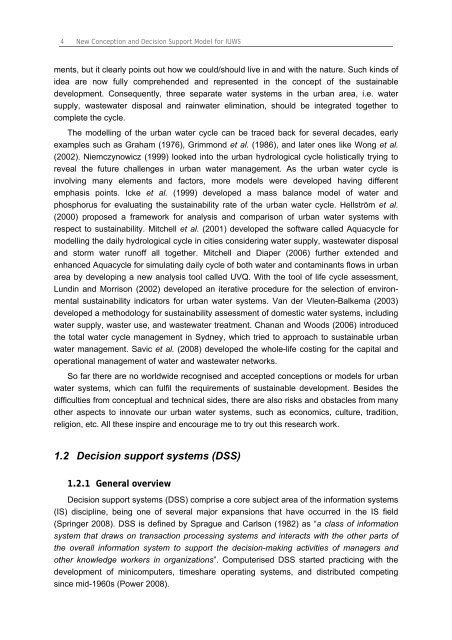Chapter 3 Decision Support Model (IUWS-DSM) - Tubdok
Chapter 3 Decision Support Model (IUWS-DSM) - Tubdok
Chapter 3 Decision Support Model (IUWS-DSM) - Tubdok
You also want an ePaper? Increase the reach of your titles
YUMPU automatically turns print PDFs into web optimized ePapers that Google loves.
4 New Conception and <strong>Decision</strong> <strong>Support</strong> <strong>Model</strong> for <strong>IUWS</strong><br />
ments, but it clearly points out how we could/should live in and with the nature. Such kinds of<br />
idea are now fully comprehended and represented in the concept of the sustainable<br />
development. Consequently, three separate water systems in the urban area, i.e. water<br />
supply, wastewater disposal and rainwater elimination, should be integrated together to<br />
complete the cycle.<br />
The modelling of the urban water cycle can be traced back for several decades, early<br />
examples such as Graham (1976), Grimmond et al. (1986), and later ones like Wong et al.<br />
(2002). Niemczynowicz (1999) looked into the urban hydrological cycle holistically trying to<br />
reveal the future challenges in urban water management. As the urban water cycle is<br />
involving many elements and factors, more models were developed having different<br />
emphasis points. Icke et al. (1999) developed a mass balance model of water and<br />
phosphorus for evaluating the sustainability rate of the urban water cycle. Hellström et al.<br />
(2000) proposed a framework for analysis and comparison of urban water systems with<br />
respect to sustainability. Mitchell et al. (2001) developed the software called Aquacycle for<br />
modelling the daily hydrological cycle in cities considering water supply, wastewater disposal<br />
and storm water runoff all together. Mitchell and Diaper (2006) further extended and<br />
enhanced Aquacycle for simulating daily cycle of both water and contaminants flows in urban<br />
area by developing a new analysis tool called UVQ. With the tool of life cycle assessment,<br />
Lundin and Morrison (2002) developed an iterative procedure for the selection of environmental<br />
sustainability indicators for urban water systems. Van der Vleuten-Balkema (2003)<br />
developed a methodology for sustainability assessment of domestic water systems, including<br />
water supply, waster use, and wastewater treatment. Chanan and Woods (2006) introduced<br />
the total water cycle management in Sydney, which tried to approach to sustainable urban<br />
water management. Savic et al. (2008) developed the whole-life costing for the capital and<br />
operational management of water and wastewater networks.<br />
So far there are no worldwide recognised and accepted conceptions or models for urban<br />
water systems, which can fulfil the requirements of sustainable development. Besides the<br />
difficulties from conceptual and technical sides, there are also risks and obstacles from many<br />
other aspects to innovate our urban water systems, such as economics, culture, tradition,<br />
religion, etc. All these inspire and encourage me to try out this research work.<br />
1.2 <strong>Decision</strong> support systems (DSS)<br />
1.2.1 General overview<br />
<strong>Decision</strong> support systems (DSS) comprise a core subject area of the information systems<br />
(IS) discipline, being one of several major expansions that have occurred in the IS field<br />
(Springer 2008). DSS is defined by Sprague and Carlson (1982) as “a class of information<br />
system that draws on transaction processing systems and interacts with the other parts of<br />
the overall information system to support the decision-making activities of managers and<br />
other knowledge workers in organizations”. Computerised DSS started practicing with the<br />
development of minicomputers, timeshare operating systems, and distributed competing<br />
since mid-1960s (Power 2008).

















